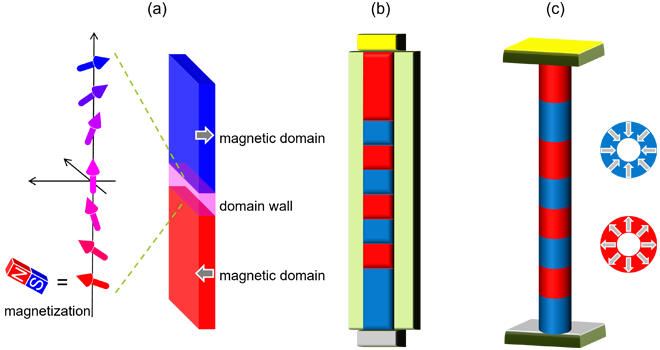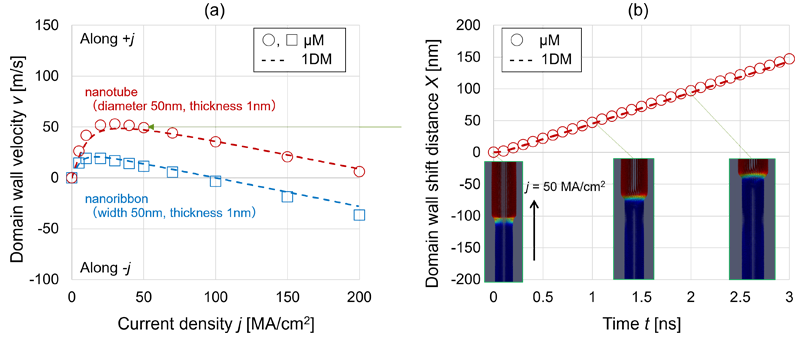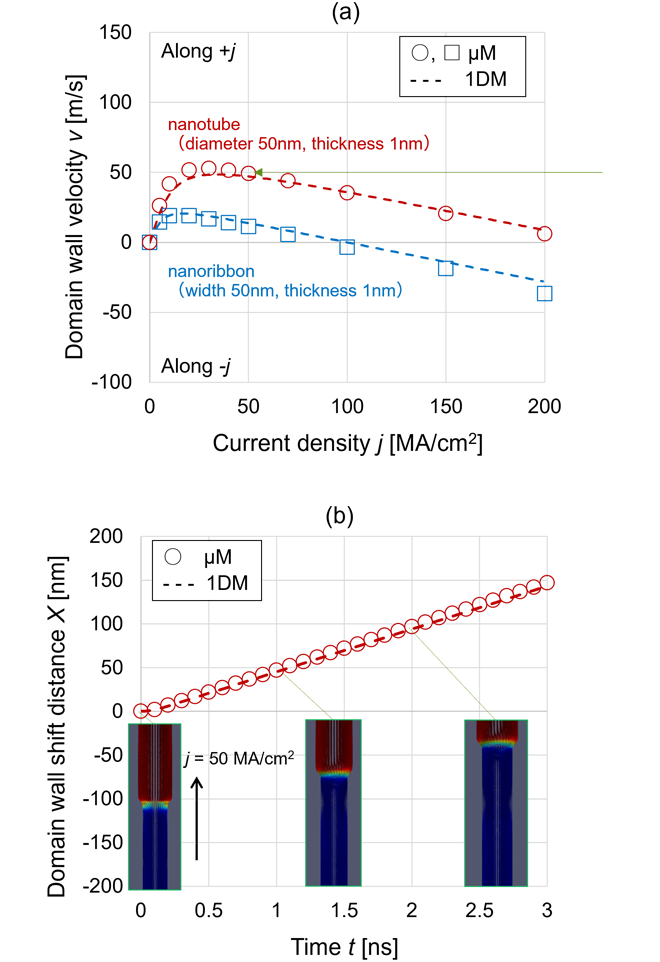Please select your location and preferred language where available.
Theoretical study of current induced domain wall motion in perpendicularly magnetized nanotubes in three-dimensional magnetic shift register
May 8, 2025
We are developing magnetic domain wall memory, which records information by creating an arrangement of magnetized regions within a magnetic nanowire medium. The boundary between areas where the magnetization direction is aligned (magnetic domains) is referred to as a “domain wall” where the magnetization configuration twists (see Fig. 1(a)). When current is passed through the nanowire, the spin angular momentum of the conduction electrons affects the domain wall, causing it to shift its position. This phenomenon is the basis of magnetic shift registers, which are expected to serve as next-generation high-capacity storage solutions.

In pursuit of achieving terabit-level storage, various three-dimensional (3D) domain wall memory structures have been proposed. A representative example is the nanoribbon structure, as shown in Figure 1(b), which features nanowires aligned along the sidewalls of a substrate[1]. In contrast, our research focuses on developing a nanotube structure, as illustrated in Figure 1(c)[2]. This nanotube structure is easier to fabricate compared to the nanoribbon structure, making it more feasible. Additionally, by utilizing perpendicular magnetic anisotropy (PMA) materials in the domain wall shift layer, there is potential to employ spin-orbit torque (SOT) to shift the domain walls more efficiently than with conventional spin transfer torque (STT), which also promises lower power consumption.
The fabrication and evaluation of 3D domain wall devices require advanced techniques. Thus, there are currently no experimental reports on current-induced domain wall motion in nanotube structures. To validate this, it is crucial to elucidate the shape effects associated with the 3D structure through theoretical studies and to apply these insights into the design of the domain wall shift layer.
In this study, we calculated the shift behavior in PMA nanotube structures using micromagnetic (μM) simulations[3], demonstrating that SOT can facilitate domain wall shift operations in nanotubes as well as in nanoribbons. Furthermore, based on analytical methods, we formulated the shape effects of PMA nanotube structures as an effective magnetic field and employed a simplified one-dimensional model (1DM)[4] to calculate the domain wall shift characteristics.
Figure 2 shows the calculation results comparing the domain wall shift characteristics of PMA nanotubes with those of PMA nanoribbons. The difference in domain wall velocities between the nanotubes and nanoribbons reflects the shape effects. In shift register memory, precise control over the domain wall shift distance is required, making it essential to quantitatively predict these shape effects. Moreover, Figure 2 confirms that the results of the 1DM closely match those obtained from the high-precision μM simulations. The 1DM significantly reduces the computational costs compared to μM simulations and provides processing speeds over 100 times faster, thereby contributing to the acceleration of the design of PMA nanotube domain wall shift layers.


This achievement was presented at the Joint MMM-Intermag 2025.
Reference
[1] S. S. P. Parkin et al., Science, Vol.320, p.190 (2008).
[2] N. Umetsu et al., 2025 Joint MMM-Intermag.
[3] E. Martinez et al., J. Appl. Phys, Vol.116, p.023909 (2014).
[4] N. Umetsu et al., J. Magn. Magn. Mater, Vol.614, p.172738 (2025).

